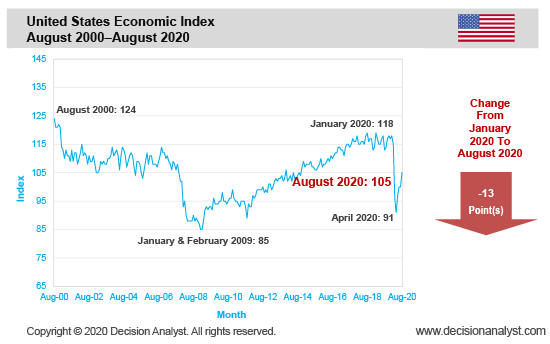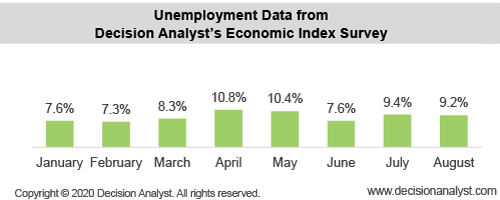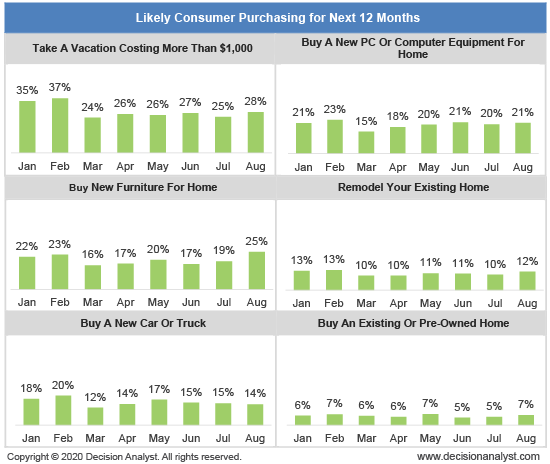U.S. Economic Recovery Slogs Ahead
Arlington, Texas—The Decision Analyst U.S. Economic Index rose to 105 in August 2020, a jump from 100 in July 2020. The August 2020 Economic Index remains well below the January 2020 time period, a deficit of 13 points. Economic activity was relatively strong in August, as the U.S. economy continued to reopen. The Economic Index indicates that the U.S. economy will tend to improve during the balance of the year, but at a slow pace. The Index tends to be a leading indicator of future economic activity, as shown by the past 20 year history of the Index shown below.

“The U.S. Economic Index continues to signal economic growth, but at a sluggish pace for the balance of 2020. But what happens during the remainder of 2020 is largely up to COVID-19. If colder weather and the reopening of businesses and schools triggers a surge of COVID-19, the U.S. economy may not grow at all this fall. If the number of COVID-19 cases continues to decline, however, the rate of U.S. economic growth could accelerate. And it’s possible that more government stimulus could happen before Election Day, and that would certainly ratchet up the economic growth rate. However, all of the government stimulus (and the Fed’s ultra-low interest rates and its purchases of mortgages and corporate bonds) brings two major future risks: (1), massive speculation that misallocates U.S. resources (and we see lots of evidence of such speculation already); and, (2), runaway inflation. Once inflation soars out of control, the Fed will have to put on the brakes to control inflation and which will bring on the next recession. The U.S. government’s and the Fed’s choices are stark and limited. Another risk factor on the horizon is major corporate layoffs, once the government’s Payroll Protection Program expires. We are likely to see many layoff announcements by corporate America during the waning months of 2020," said Jerry W. Thomas, President/CEO, Decision Analyst.

“In Decision Analyst’s Economic Index survey, U.S. adults are asked to self-classify their employment status. They have to say they are ‘unemployed but looking for a job’ to be counted as unemployed,” said Thomas “The U.S. employment picture has been improving for the past five months, but the U.S. unemployment rate according to Decision Analyst’s tracking survey remains at elevated levels. In reviewing the Decision Analyst unemployment estimates, June’s 7.6% rate appears to be an anomaly on the low side. The overall pattern suggests five months of gradually improving unemployment data. The August rate (9.2%) is only a slight improvement from the 9.4% rate in July 2020.”
“However, planned future purchases (see graphs below) continued, on average, to indicate that consumer spending (roughly 70% of the U.S. economy) is likely to remain reasonably stable for the balance of 2020. The graphs below show the percentage of U.S. households who say they are likely to make certain purchases in the next 12 months.”

"The future purchase-intent results in these charts continue to suggest that people are working to make their homes more comfortable; intentions to purchase new furniture for the home, and new computer equipment, remain at elevated levels. Vacation travel plans indicate more pain and suffering in the hospitality industry (hotels, restaurants, entertainment venues, etc.). Cars and truck sales are likely to end 2020 on a weak note, while future sales of existing and new homes show signs of potential increases. All together, these graphs point to continued economic growth in 2020, but the rates of growth will be modest," said Thomas.
Methodology
The Decision Analyst Economic Index is based on a monthly online survey of several thousand households balanced by gender, age, and geography. The scientific survey is conducted in the last 10 days of each month. The Economic Index is calculated from 9 different economic measurements using a sophisticated econometric model. The result is a snapshot of coming economic activity in each country surveyed, as seen through the eyes of representative consumers living in the respective countries.
Decision Analyst conducts its concurrent economic surveys each month in Argentina, Brazil, Canada, Chile, Colombia, France, Germany, India, Italy, Mexico, Peru, the Russian Federation, Spain, and the United States. Whenever the Decision Analyst Economic Index is greater than 110, it tends to signal an expanding economy. An Index value of 90 to 110 suggests a no-growth or slow-growth economy, and near or below 90 generally indicates economic contraction. These guidelines vary by country, however.
About Decision Analyst
Decision Analyst (www.decisionanalyst.com) is a global marketing research and analytical consulting firm specializing in strategy research, new product development, advertising testing, and advanced modeling for marketing decision optimization. For over 40 years, the firm has delivered competitive advantage to clients throughout the world in consumer-packaged goods, telecommunications, retail, technology, medical, and automotive industries.
Media Contact
Cristi Allen
Publicity
Email: callen@decisionanalyst.com
Phone: 1-800-ANALYSIS (262-5974) or 1-817-640-6166
Address: 604 Avenue H East
Arlington, TX 76011
Library
Logos & Images
If you are doing a story on Decision Analyst or using any of our published data, news releases or articles, you must cite "Decision Analyst" as the source of the information.
If you use any of the charts or tables from the press releases or other published materials, please email Cristi Allen at callen@decisionanalyst.com to let us know which graphics you took and for what newspaper, magazine, or website it was used.

